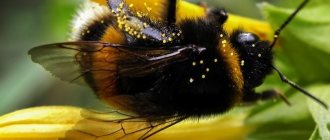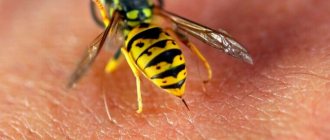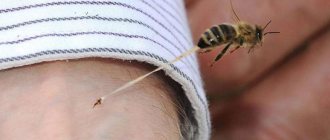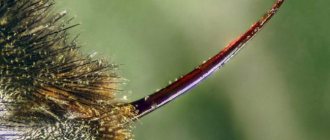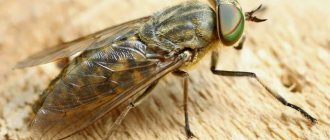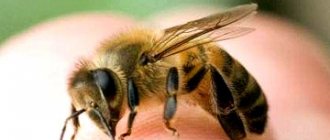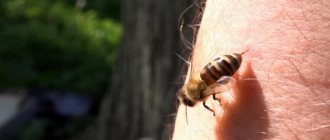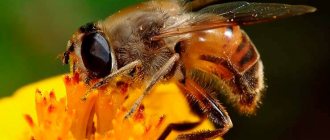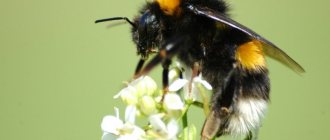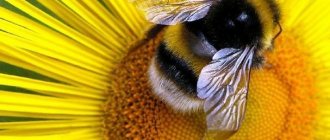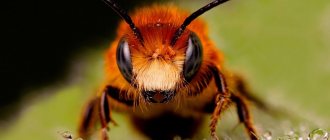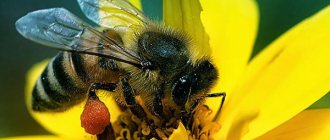Among the insects flying in the meadow, there are three genera that a person encounters quite often in his life: the bee, the wasp and the bumblebee. It's difficult to confuse them. They vary greatly in color and size. But sometimes this is possible if you do not delve into the details of the color of a large insect that has flown into the window. We are accustomed to the fact that the bumblebee is the largest of these three species, but the predatory wasp - the hornet - is much larger, and the body length of some bumblebees is less than that of a bee. Therefore, you will have to understand in more detail how a wasp, a bee and a bumblebee differ from each other, and how they are similar.
Lifestyle
Insects also differ in their lifestyle:
Domestication and Taming:
Wasps also live in groups, where responsibilities are clearly distributed between them. Sometimes they prefer to live as hermits. Their nest is round, as if made of thin crumpled paper. In fact, they prepare it from rotten wood and dry plants.
Dirt and small debris are used to build the nest. They attach their nests to the walls of a house, large tree branches, thick grass, even in a thick plant stem, a discarded mitten, or a piece of cardboard.
Differences
Bee, bumblebee and wasp
There are much more signs by which you can determine who is flying around. Using them, it is unmistakably possible to recognize whether an insect belongs to a particular family.
In the first place is “hairiness”. In terms of hairiness, the rating of insects looks like this:
- Bumblebee.
- Bee.
- Wasp.
Large wasps and small bumblebees are easy to confuse even by color. Among these unrelated insects, there are species that are similar in color and arrangement of markings. But wasps are always “bald”.
The bee occupies an intermediate place in terms of hairiness and often also appears “bald” to the inattentive observer. In fact, it has bristles, but they are short and sparse.
Behavior
A wasp and a bee can live in a group, accumulating up to several thousand individuals and alone. The queen begins to build a wasp's nest; first she builds one layer, then the rest. She then mates once with the drone and begins laying larvae, providing food.
At the beginning of summer, the female lays larvae, from which sterile individuals hatch. Closer to autumn, the larvae from which individuals will emerge are capable of reproduction. They develop in a cell, feeding on pre-prepared immobilized insects. Sometimes wasps lay larvae in the body of large beetles. During its development, its status gradually increases. She starts with cleaning the nest and ends with getting food. In autumn, all ordinary individuals and drones freeze, leaving only the queen alive.
In a bee swarm there is also a clear division of responsibilities. Some individuals deliver nectar to the hive. Others put nectar in honeycombs, while others clean the hive of dead individuals. There are cell cleaners, caring for babies and guards who stand at the entrance, the job is to not let strangers through. Defenders protect the home from attackers, these include humans and bears.
Each ordinary worker gradually goes through all the stages of the listed works throughout her life. This is how nature prescribed it. The young individual begins by cleaning the honeycomb. Then she produces milk and begins feeding the queen and young larvae. Then the bee feeds the older larvae with beebread. Then it takes nectar from collecting bees, or stores it in cells. Then the time comes for her to remove the garbage, when her wax glands begin to work, she begins to build and plug the honeycomb. After the 18th day, the glands that produce poison begin to act, then they are trusted to protect the hive.
The bee colony accumulates a supply of beebread for the winter months and for inclement summer days. Closer to autumn, when there is little food, they destroy the drones.
The queen flies out into the wild to mate. In free flight, she chooses a more viable male, sometimes from another hive.
Their similarities
All three species of insects belong to the same family Hymenoptera. These are social insects that build nests and live in families where there is a strict division of responsibilities. The family consists of female queens, male workers, and drones, who are kicked out of the family by the female workers after the queen is impregnated. The family defends its nests with all available forces.
Bees and bumblebees belong to the genus of true bees, so they can make honey. Bumblebees collect better quality honey, but not in the same quantities as bees and do not store it for as long. Bumblebees and bees are unique in that they pollinate a variety of plants to ensure good harvests.
Wasps and bumblebees have a smooth sting, which people use many times to protect themselves from enemies. But in bees it is not smooth, therefore, having bitten a person, he cannot remove him from the person’s body and he dies.
These are almost all similarities as they only reflect differences.
Nest arrangement
Bees build their hive from wax (they secrete it themselves), making strictly symmetrical honeycombs inside. Domestic bees live in special houses that beekeepers build for them. A hive of wild bees can be located in a hollow tree or in a crevice of a steep rock.
Wasps make their home from parchment, which is made by chewing wood or other plant cellulose. Their hive is round in shape, gray in color, and looks papery. Wasps attach the hive to the branches of a tree or the ceilings of rarely visited buildings, and sometimes they build it in the ground.
The nest of bumblebees is called a bombidarium; insects make it in burrows of small animals, hollows, and abandoned bird nests. Bumblebees, like bees, build the first cells of their nest with wax. To construct subsequent cells, they use capsules of already hatched larvae.
Hornets
The most dangerous relatives of my favorite bees for humans. Not only are they intimidating in size (they can be up to 6 cm in length), but they also do not have serrations on their stingers. This means that after being bitten they do not die, but continue to sting until the poison runs out. And they have a lot of it. So much so that meeting them can be fatal.
But despite the horrors that I told you about, you cannot destroy their hives when you meet them. Hornet larvae feed on insects. A large family of hornets can eat half a kilo a day. So without them, the ecosystem will be very disrupted.
Their houses are very ugly on the outside and extremely slender on the inside. Outwardly, they resemble the thermal insulation on old panel houses - sloppy, pimply heaps. Inside such houses there are even compartments with honeycombs of several floors.
I think I wrote about everyone. If I missed anyone, tell me. I missed your comments.
Behavior in stressful situations
It is important for everyone to know that the behavior of these insects depends on the influence of various factors. You can anger both some insects and others. Bees always protect their hive, which contains the queen. In case of penetration into the hive, the bees immediately, as a whole family, come to the defense. Wasps act in much the same way and if their nest is attacked, you can get numerous bites. There is an opinion that wasps can attack just like that, but this is rather a myth. They sting only if they are provoked, otherwise wasps can fly and not hurt anyone. In any case, you need to be careful with both bees and wasps.
Interesting Facts
These insects are interesting because:
- After the bees fertilize the queen with males, they attack them and drive them away from the colony. After this, they quickly die, since they cannot provide food on their own.
- Wasps can also make honey, but no one has seen this. At the bottom of the cell there is a microscopic volume of honey. The larvae need to eat something first. Then they move on to eating protein foods.
- Bumblebees appear on the inflorescences earlier than anyone else and begin to pollinate plants before anyone else.
- The hornet is a true predator that prefers to feed on live insects.
- A worker bee can transmit information to its relatives about where the food product is located.
Each insect has its own pros and cons. Unfortunately, many people unjustifiably destroy insects, although there are no absolutely useless living creatures in nature. If some species disappear, humanity simply will not be able to survive.
Nature of the bites
The wasp stings are much more painful, but the nature of the bites has its own similarities.
As mentioned above, wasps can sting several times. At the same time, there is a risk of infection, since wasps often visit places where there is complete unsanitary conditions. As for the bee, the sting is not so dangerous, since the only thing bees do is collect nectar from flowers - honey plants.
Every person should be able to provide first aid for wasp and bee stings. Ignorance of these rules, as well as illiterate actions, can harm human health. This is especially true for people prone to allergies, young children, expectant mothers and people with poor health.
As a result of a bee or wasp sting, the following characteristic signs appear:
In cases where the human body is hypersensitive, the reaction may be as follows:
Anaphylactic reactions occur if the degree of intoxication of the body is more severe:
What they look like
To be able to easily recognize an insect, you need to know what they look like, each of them has its own distinctive appearance characteristics, let’s get acquainted with them:
- Bee. They are distinguished by the most modest color. There is no sharp transition between the chest and abdomen, the body is shaggy. They have fairly thick legs, which are covered with hairs, and have small jaws.
- Wasp. We all know about the term “wasp waist” and this really only applies to this type of insect; there is a sharp transition between the abdomen and thorax. The body is more elongated and smooth. It has a fairly bright color of the body, there are bright yellow splashes on the black back, and the abdomen is painted with contrasting bright yellow and black stripes. The paws are yellow. The oral apparatus is equipped with fairly powerful mandibles.
- Bumblebee. It has a more impressive body size; its distinctive characteristic is the fluffy cover throughout the body. He also has a beautiful, bright color, has yellowish-red stripes, maybe with a red tint. Bumblebees are found in nature completely black.
- Hornet. They are the largest representatives, their body size can reach 5 cm. They are also distinguished by fairly large and powerful jaws. Outwardly, it resembles a wasp, but the striking difference between the hornet is the absence of a thin waist.
Who stings more
Not every person can objectively assess painful sensations. Not everyone has been bitten by both animals. American entomologist Justin Schmidt asked this question and decided to compare the sensations obtained from the bites of various insects. Over the course of several years, the scientist subjected himself to attacks by several thousand insects, after which he recorded his observations and sensations. After his experiments, he invented the scale. According to this scale, a wasp sting is like burning the tip of your tongue with a cigarette. He compared a bee sting to a skin burn from an open fire. Schmidt notes that in most cases a wasp sting is more unpleasant, but the peculiarity of a bee sting is that, due to the teeth, the sting gradually goes deeper and deeper into the skin, prolonging the painful sensation.
Coloring
It is quite easy to distinguish a bee from a bumblebee and a wasp by the degree of color: the first is always dark brown. The stereotype of striped honey collectors comes from cartoons. You can compare photos of a bee and a bumblebee. The differences will be immediately noticeable.
The other two insects can have not only striped, but also almost uniform coloring. For example, glitter wasps are iridescent, and typhias are solid black. But usually people only consider wasps to be insects with black and yellow stripes on their bodies. This does not prevent representatives of other families from also biting painfully and sometimes being more dangerous.
Bite symptoms
Externally, the manifestations are practically no different. It is difficult to assess the degree of pain, if a wasp or bee stings for the first time, a person has nothing to compare with. The bite looks like this:
A photo of a bee or wasp sting is shown below. You can carefully examine all the features of the traces of an attack by striped insects.
On a note!
If a wasp or bee stings in the leg, injects poison into the arm, the entire limb swells. If you are bitten on the neck, face, or tongue, the likelihood of swelling of the larynx increases. In severe cases, Quincke's edema develops. In the absence of qualified help, a person risks dying. If you are bitten by bees or attacked by a swarm of wasps, the dose of poison in the blood increases significantly and anaphylactic shock may occur.
A severe allergic reaction provokes:
At home, it is allowed to treat a wasp or bee sting in case of a local allergic reaction. If you experience deterioration in your health, difficulty breathing, or swelling of the larynx, you should immediately call an ambulance or go to a sanitary checkpoint accompanied by other people.
What do they eat?
Bumblebees, bees and many species of wasps lead a social lifestyle. However, bumblebees act alone in search of food. They feed mainly on flower nectar and pollen. When the air has not yet warmed up enough, the bumblebee, quickly contracting its chest muscles, is able to warm up its body to the required 40 °C. This interesting ability allows them to fly out earlier than their “competitors” and collect the first nectar.
Bees fly around to form a small group and collect nectar and pollen from flowering plants. Wasps fly in flocks of 2-3 dozen individuals and prefer to feed on animal food (small insects). The victim is divided into pieces and taken to the hive to feed the larvae. Often the wasps kill the bees and take the honey.
First aid for a bee or wasp sting
After an insect attack, you need to take certain actions to avoid complications and reduce allergies.
- Rinse the wound with clean cold water. The procedure will help wash away any remaining poison and remove dirt. At home, use laundry soap.
- Disinfect. They use ammonia, medical alcohol, and boric alcohol. And also hydrogen peroxide, a medicinal herbal tincture of medicinal herbs.
- Neutralize the effect of the poison. Use vinegar and citric acid. To prepare the solution, add 1 teaspoon of vinegar or 0.5 teaspoon of acid to a glass of water. They wipe the sore spot, make lotions and compresses. If it is not possible to prepare a solution, apply a piece of sugar for 5 minutes.
- Don't let the poison spread. Ice cubes or cold objects are applied to the bite site for 5 minutes - a bottle of water, meat from the freezer, a heating pad. Cold constricts blood vessels, prevents the spread of poison, and also relieves swelling and eliminates pain.
- Reduce inflammation. You can treat the bite with a decoction or tincture of calendula, chamomile, or valerian. Or they use pharmaceutical drugs.
If you have a severe allergic reaction, you need to take an antihistamine as quickly as possible. Be sure to take medicine for multiple bites, if a wasp or bee stings you on the neck or face.
What not to do about bee and wasp stings
Many people misunderstand this situation, which can cause serious damage to the human body. As a rule, a person is overcome by panic and, as a result, wrong actions that can lead to negative consequences.
So, what not to do:
You can't just lie there. An acceptable option is a half-sitting position. In this position, the load on the heart is minimal, and in case of vomiting, the person cannot be harmed.
It is not at all difficult to distinguish a bee from a wasp. If we talk about benefits, then the bee brings more benefits, although wasps also have their purpose and take their place in the ecosystem. It is wrong to say that wasps are useless insects. Both will bite if you anger them or interfere with their living space. If you do not provoke insects, they will not attack humans. Sometimes it is the person himself who is to blame for being bitten by insects. For some reason they think they won't get hurt.
Under certain conditions, both a wasp and a bee can bite. In such cases, you need to know what to do. In most cases, when the human body reacts adequately to insect bites, the bites go away on their own. The only problem is children who can scratch the bite site and then secondary infection is possible, as well as people prone to allergies. However, they should always have antihistamines with them. The main thing in such a situation is not to get confused, otherwise unpredictable consequences are possible.
Preventing insect stings
It is difficult to avoid encounters with insects outside the city, since there a person finds himself visiting nature. Therefore, it is worth carrying allergy pills with you. When visiting the apiary, wear special clothing. When making jam, close the windows so as not to tempt wasps and bees. When picking fruit in the garden, protect your hands with thick gloves or inspect each fruit for insects.
The favorite delicacy of wasps, hornets, and bees is ripe sweet fruits: pears, plums, apples
When relaxing in the forest or on the river bank, be careful:
- when looking for a parking place, first check to see if there are insect nests nearby;
- do not walk barefoot;
- do not disturb the houses of wasps and hornets, they will certainly attack;
- when they see a stinging insect, they behave calmly and do not wave their arms so as not to provoke aggression;
- the biting insect is not killed; the body of the killed one exudes an enzyme that will provoke an attack by its relatives.
When going outdoors, do not use perfumes containing apple and banana fragrances. The listed odors attract hornets and wasps.
Stinging insect bites are treated with compresses and ointments. In case of allergies, antihistamines are used. If after a bite the victim’s breathing is impaired and his consciousness is swimming, immediately call an ambulance
To avoid insect attacks, be careful when picking fruit, making jam and finding a place to camp in nature.
Folk remedies
Symptoms disappear completely within a week. All this time the sore spot hurts and itches. To speed up tissue regeneration, folk remedies are used. They are also used if it is not possible to treat the wound with professional antiseptics.
On a note!
The juices of potatoes, carrots, beets, lemon, and grapefruit have anti-inflammatory properties. They make compresses, lotions, and simply wipe the wound.
Certain blood types sting people more often
Those who smell good to mosquitoes and bumblebees are often stung. Mosquitoes are first attracted to components of human sweat. It's not just sweat, breath, or more specifically carbon dioxide that can attract mosquitoes to spy on their victims. Other odors that attract them are lactic acid, uric acid, body heat and ammonia.
This explains, for example, why athletes are more likely to be stung than other people, because they produce significantly more lactic acid during exercise. The composition of bacteria on the skin also plays an important role. Blood type 0
is the most popular according to tests by the Institute of Pest Control Technology.
Medicines for a normal reaction to a bee or wasp sting
They use a product based on natural ingredients, herbal extracts, and essential oils.
If no improvement in the condition of the skin is observed within 2 days, agents are used to reduce the activity of histamines.
Features of the genus
So who are the hornets? The genus Hornets belongs to the family of true wasps. That is why representatives of this genus fit well into the external framework inherent in ordinary wasps. At the same time, there are some differences that will not allow these, albeit close, but still different taxonomic groups of Hymenoptera insects, to be confused.
Stinging insects.
What does a hornet look like next to a wasp? Large hornets differ from other wasps primarily in their large size. The dimensions of an insect such as a hornet range from 1.8 to 5.5 cm in length, depending on the species. Also, the wingspan of these largest wasps in the world can reach 8 cm. And this large wasp, in addition to its serious dimensions, has very powerful and impressive jaws, which also differs from most other wasps.
Among the differences between representatives of the hornet genus and other wasps, some differences in color should also be mentioned. The hornet insect has the same striped abdomen as most wasps. Moreover, if the color of the wasp is dominated by only two colors, namely black and yellow, then the color of the hornet is somewhat darker, and orange and brown shades have found their place in the color palette.
Well, we cannot ignore that unpleasant part of the story about this huge wasp, which concerns the main weapon of these stinging hymenoptera. It’s no secret that wasps tend to use their sting for its intended purpose in case of danger.
Although, it must be said that the wasp’s sting performs not only the function of an injection needle for treating a presumptuous enemy with a portion of poison. It is also a reduced insect ovipositor.
Therefore, such cinematic epithets as “murder hornets” are often and, it must be said, not unreasonably used in relation to these not very cocky, but certainly capable of standing up for themselves insects.
Treatment for wasp sting allergy
An allergic reaction to a bee or wasp sting has quite acute and quickly manifested symptoms. In this case, you need to act quickly in order to slow down the spread of toxins as much as possible and neutralize their effect on the body.
The victim is given an antihistamine that suppresses the development of the allergic process. It can be:
The drugs are taken in the dosage and frequency prescribed by the doctor. Medicines such as Erius, Eden, Claritin, Kestin are indicated for children.
In addition to antiallergic medications, special ointments and gels will help to relieve swelling from a wasp sting:
These products also have an antihistamine effect, relieve redness and swelling, and relieve itching.
It is possible to use hormonal drugs, for example, Fluorocort or Diprosalic, but you need to take into account possible side effects.
It is also advisable to prescribe adsorbent drugs:
These drugs bind toxins and quickly remove them from the blood, thereby cleansing the body of poison.
In case of severe manifestations of allergies, the victim will be helped by:
The victim is urgently hospitalized and provided with all necessary care in a hospital setting.
Differences between bees and wasps and bumblebees
Of course, the first difference that catches your eye when you see these representatives is the color of the body. Wasps have quite bright colors, one might say provocative. Bumblebees are much darker in color and also have a large rounded body, while wasps have a “famous” waist.
The diet of bees and hornets includes pollen and nectar, which they collect with the help of their proboscis. But wasps are omnivores, except for pollen and nectar, they do not refuse fruit juice, and other small insects, in addition, they attack hives to taste honey. When attacking, they often use large, powerful jaws, with which they easily kill their prey.
When to seek help from doctors
You should immediately call an ambulance if:
Popular message topics
- Jumping
All these types of jumping belong to the discipline of athletics. Which they begin to teach in general educational institutions, and in special children’s circles, if you study hard and train, you can become a famous Olympic athlete - Inclusive education
Inclusive education is a learning process during which all people, regardless of their physical and mental state, learn together. In inclusive education, children are raised in specially created conditions, - Growing mushrooms
Today, mushrooms are a very popular food product. You can prepare a wide variety of dishes from them: soups, sauces, salads, and mushrooms can also be pickled or pickled. Mushrooms can be collected in the forest, or you can buy them in a store.
Who bites harder?
Hornets and wasps are the most aggressive; they have a thin sting with which they pierce the skin deeply several times. The bite is painful and burning, the affected area swells greatly. This may cause an allergic reaction. Wasps are also able to give a signal for the entire swarm to join them. These insects continue to live after being bitten.
It is difficult to anger a bee, but it leaves a sting in the body, striking only once, and subsequently dies. Bees sting only in extreme danger. Their bite is not so painful.
The most benevolent of all is the bumblebee; he attacks in exceptional cases. Its bite is less painful. Only the female has a sting; she does not lose it, and sometimes bites several times. A bumblebee sting can cause severe allergies and fever, and is especially dangerous for children.
Properties of the sting
Indian scientists, together with colleagues from Ohio State, conducted research and determined that wasp and bee stings were not created so simply. There are differences between them:
- curved in a wasp;
- direct from the bee.
Both insects have two movable barbs at the end, sharp as a dagger. They make it easier to pierce the body surface.
Using equipment, scientists discovered a feature in both stings - the presence of voids, due to which the sting is light but durable.
wasp sting
Bee sting
An important discovery was that the stings at the base are less elastic and soft than those at the top. Because of this, the sting enters the skin painlessly; the insect has time to inject poison before the person feels it and tries to shake it off.
Studies have also shown that insects bite at an angle, which is why the sting remains strong for a long time.
On the other hand, the bee cannot remove the sting because it has serrations and part of the intestine breaks off, causing the insect to die.
The wasp sting is thin, curved and pointed. After injecting the poison, the insect easily pulls it out.
The composition of the toxic substance varies among different types of wasps. But only females sting, since their sting (in addition to their weapon) is an ovipositor.
Lifestyle, main functions
The behavior of a fertile female and the lifestyle of different species of the wasp family differ, but the main mission - prolongation of the genus - remains the same.
Single queens
They are active in early spring – the mating season begins. Eggs begin to be laid in summer. Before this, they live for their own pleasure - collecting nectar from plants, drinking juices of fruits and berries. They do not form multi-tiered nests; they dig holes in the ground for laying eggs.
The queen prepares the nest in light, easy-to-digging soil. The depth reaches 5 cm; a single cell is located at the bottom.
The female paralyzes the larvae of large beetles, spiders, and various insects, drags them into a hole, and lays an egg on the body. After a few days, a larva appears and devours the victim within 14 days.
In this way, the queen provides the larva with separate housing and food. At the end of the cycle, pupation occurs. In the pupal state, the larva overwinters; in the spring, young females and males independently emerge to the surface, and the mating process begins.
Public vespins
The Wasp Queen is the founder of a large family, within which there is a clear hierarchy. The majority of the society consists of working individuals - immature females. They build a nest, provide protection, look for food, and feed the larvae.
Queen wasp of public vespins
The young queen lays the foundation of a nest in a favorable location. Initially forms a leg, then lays out the honeycomb. An egg is laid in each cell. After 3-4 days, sedentary larvae appear, which need to be fed for 2 weeks. The queen hunts spiders and insects, since the cubs require protein food. Chews, forms balls, gives to larvae.
At the end of the cycle, the larva pupates, after 2-3 days a working individual appears, to which the queen entrusts all responsibilities for building the nest, searching for food, and caring for the larvae. She herself becomes the queen of the family, only laying eggs.
In August, large honeycombs are built near the nest, where special eggs are placed. From them a generation of young sexually mature females and males appears. They live in the nest for some time, come out in the fall, and mating occurs. With the onset of cold weather, working individuals die, females find refuge in wood for wintering.
According to some sources, the former queen dies in November, according to others, she hides and spends the winter. Forms a new family in the spring and has the ability to return to its original places. From here the queen's life expectancy is calculated from 1 to 2 years.
Paper sheets
They occupy an intermediate place between primitive solitary wasps and social vespins. There may be several mature queens in one nest, but only one plays the role of queen. The rest help her increase the population size. The number of hives reaches several hundred individuals. Otherwise, the functions of the uterus are identical to vespins.
Paper wasp queen
In nature, there are many species, subspecies, and genera of wasps. Among them there are predatory queens or parasites that sneak into someone else's nest, kill the true queen, and take her place. The enslaved family cares for the larvae of the new queen, feeding her herself. Over time, only her offspring remain in the hive.
